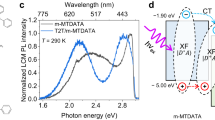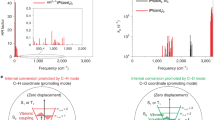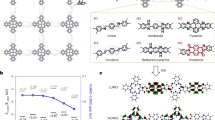Abstract
Controlling the alignment of the emitting molecules used as dopants in organic light-emitting diodes is an effective strategy to improve the outcoupling efficiency of these devices. To explore the mechanism behind the orientation of dopants in films of organic host materials, we synthesized a coumarin-based ligand that was cyclometalated onto an iridium core to form three phosphorescent heteroleptic molecules, (bppo)2Ir(acac), (bppo)2Ir(ppy) and (ppy)2Ir(bppo) (bppo represents benzopyranopyridinone, ppy represents 2-phenylpyridinate, and acac represents acetylacetonate). Each emitter was doped into a 4,4′-bis(N-carbazolyl)-1,1′-biphenyl host layer, and the resultant orientation of their transition dipole moment vectors was measured by angle-dependent p-polarized photoluminescent emission spectroscopy. In solid films, (bppo)2Ir(acac) is found to have a largely horizontal transition dipole vector orientation relative to the substrate, whereas (ppy)2Ir(bppo) and (bppo)2Ir(ppy) are isotropic. We propose that the inherent asymmetry at the surface of the growing film promotes dopant alignment in these otherwise amorphous films. Modelling the net orientation of the transition dipole moments of these materials yields general design rules for further improving horizontal orientation.
This is a preview of subscription content, access via your institution
Access options
Subscribe to this journal
Receive 12 print issues and online access
$259.00 per year
only $21.58 per issue
Buy this article
- Purchase on Springer Link
- Instant access to full article PDF
Prices may be subject to local taxes which are calculated during checkout






Similar content being viewed by others
References
Scharber, M. C. et al. Design rules for donors in bulk-heterojunction solar cells—towards 10% energy-conversion efficiency. Adv. Mater. 18, 789–794 (2006).
Jurow, M. J. et al. Controlling morphology and molecular packing of alkane substituted phthalocyanine blend bulk heterojunction solar cells. J. Mater. Chem. A 1, 1557–1565 (2013).
Tsao, H. N. et al. The influence of morphology on high-performance polymer field-effect transistors. Adv. Mater. 21, 209–212 (2009).
Yokoyama, D. Molecular orientation in small-molecule organic light-emitting diodes. J. Mater. Chem. 21, 19187–19202 (2011).
Namdas, E. B., Ruseckas, A., Samuel, I. D. W., Lo, S.-C. & Burn, P. L. Photophysics of fac-tris(2-phenylpyridine) iridium(III) cored electroluminescent dendrimers in solution and films. J. Phys. Chem. B 108, 1570–1577 (2004).
Baldo, M. A. et al. Highly efficient phosphorescent emission from organic electroluminescent devices. Nature 395, 151–154 (1998).
Baldo, M. A., Lamansky, S., Burrows, P. E., Thompson, M. E. & Forrest, S. R. Very high-efficiency green organic light-emitting devices based on electrophosphorescence. Appl. Phys. Lett. 75, 4–6 (1999).
Mladenovski, S., Neyts, K., Pavicic, D., Werner, A. & Rothe, C. Exceptionally efficient organic light emitting devices using high refractive index substrates. Opt. Express 17, 7562–7570 (2009).
Reineke, S. et al. White organic light-emitting diodes with fluorescent tube efficiency. Nature 459, 234–238 (2009).
Brütting, W., Frischeisen, J., Schmidt, T. D., Scholz, B. J. & Mayr, C. Device efficiency of organic light-emitting diodes: Progress by improved light outcoupling. Phys. Status Solidi A 210, 44–65 (2013).
Schmidt, T. D. et al. Evidence for non-isotropic emitter orientation in a red phosphorescent organic light-emitting diode and its implications for determining the emitter’s radiative quantum efficiency. Appl. Phys. Lett. 99, 163302 (2011).
Forrest, S. R. The path to ubiquitous and low-cost organic electronic appliances on plastic. Nature 428, 911–918 (2004).
Sasabe, H. & Kido, J. Development of high performance OLEDs for general lighting. J. Mater. Chem. C 1, 1699–1707 (2013).
Sasabe, H. & Kido, J. Recent progress in phosphorescent organic light-emitting devices. Eur. J. Org. Chem. 2013, 7653–7663 (2013).
Mayr, C., Schmidt, T. D. & Brütting, W. High-efficiency fluorescent organic light-emitting diodes enabled by triplet–triplet annihilation and horizontal emitter orientation. Appl. Phys. Lett. 105, 183304 (2014).
Liehm, P. et al. Comparing the emissive dipole orientation of two similar phosphorescent green emitter molecules in highly efficient organic light-emitting diodes. Appl. Phys. Lett. 101, 253304 (2012).
Mayr, C. & Brutting, W. Control of molecular dye orientation in organic luminescent films by the glass transition temperature of the host material. Chem. Mater. 27, 2759–2762 (2015).
Flämmich, M. et al. Oriented phosphorescent emitters boost OLED efficiency. Org. Electron. 12, 1663–1668 (2011).
Helander, M. G. et al. Chlorinated indium tin oxide electrodes with high work function for organic device compatibility. Science 332, 944–947 (2011).
Lamansky, S. et al. Highly phosphorescent bis-cyclometalated iridium complexes: Synthesis, photophysical characterization, and use in organic light emitting diodes. J. Am. Chem. Soc. 123, 4304–4312 (2001).
Lassiter, B. E. et al. Organic photovoltaics incorporating electron conducting exciton blocking layers. Appl. Phys. Lett. 98, 243307 (2011).
Kim, K.-H. et al. Phosphorescent dye-based supramolecules for high-efficiency organic light-emitting diodes. Nature Commun. 5, 4769 (2014).
Kim, K.-H., Moon, C.-K., Lee, J.-H., Kim, S.-Y. & Kim, J.-J. Highly efficient organic light-emitting diodes with phosphorescent emitters having high quantum yield and horizontal orientation of transition dipole moments. Adv. Mater. 26, 3844–3847 (2014).
Kim, S.-Y. et al. Organic light-emitting diodes with 30% external quantum efficiency based on a horizontally oriented emitter. Adv. Funct. Mater. 23, 3896–3900 (2013).
Lee, J.-H. et al. Finely tuned blue iridium complexes with varying horizontal emission dipole ratios and quantum yields for phosphorescent organic light-emitting diodes. Adv. Opt. Mater. 3, 211–220 (2014).
Graf, A. et al. Correlating the transition dipole moment orientation of phosphorescent emitter molecules in OLEDs with basic material properties. J. Mater. Chem. C 2, 10298–10304 (2014).
Reineke, S., Rosenow, T. C., Lüssem, B. & Leo, K. Improved high-brightness efficiency of phosphorescent organic LEDs comprising emitter molecules with small permanent dipole moments. Adv. Mater. 22, 3189–3193 (2010).
Reineke, S., Schwartz, G., Walzer, K., Falke, M. & Leo, K. Highly phosphorescent organic mixed films: The effect of aggregation on triplet–triplet annihilation. Appl. Phys. Lett. 94, 163305 (2009).
Kim, K.-H. et al. Controlling emitting dipole orientation with methyl substituents on main ligand of iridium complexes for highly efficient phosphorescent organic light-emitting diodes. Adv. Opt. Mater. 3, http://dx.doi.org/10.1002/adom.201500141 (2015)
Moon, C.-K., Kim, K.-H., Lee, J. W. & Kim, J.-J. Influence of host molecules on emitting dipole orientation of phosphorescent iridium complexes. Chem. Mater. 27, 2767–2769 (2015).
Ren, X. et al. Coumarin-based, electron-trapping iridium complexes as highly efficient and stable phosphorescent emitters for organic light-emitting diodes. Inorg. Chem. 49, 1301–1303 (2010).
Jaguar v. Version 8.4r17 (Schrödinger LLC, 2014); www.shrodinger.com/Jaguar
Becke, A. D. Density-functional thermochemistry. III. The role of exact exchange. J. Chem. Phys. 98, 5648–5652 (1993).
Hay, P. J. & Wadt, W. R. Ab initio effective core potentials for molecular calculations. Potentials for the transition metal atoms Sc to Hg. J. Chem. Phys. 82, 270–283 (1985).
Stephens, P. J., Devlin, F. J., Chabalowski, C. F. & Frisch, M. J. Ab initio calculation of vibrational absorption and circular dichroism spectra using density functional force fields. J. Phys. Chem. 98, 11623–11627 (1994).
Frischeisen, J., Yokoyama, D., Endo, A., Adachi, C. & Brütting, W. Increased light outcoupling efficiency in dye-doped small molecule organic light-emitting diodes with horizontally oriented emitters. Org. Electron. 12, 809–817 (2011).
Frischeisen, J., Yokoyama, D., Adachi, C. & Brütting, W. Determination of molecular dipole orientation in doped fluorescent organic thin films by photoluminescence measurements. Appl. Phys. Lett. 96, 073302 (2010).
Mayr, C. et al. Efficiency enhancement of organic light-emitting diodes incorporating a highly oriented thermally activated delayed fluorescence emitter. Adv. Funct. Mater. 24, 5232–5239 (2014).
Weber, W. H. & Eagen, C. F. Energy transfer from an excited dye molecule to the surface plasmons of an adjacent metal. Opt. Lett. 4, 236–238 (1979).
Kawamura, Y., Brooks, J., Brown, J. J., Sasabe, H. & Adachi, C. Intermolecular interaction and a concentration-quenching mechanism of phosphorescent Ir(III) complexes in a solid film. Phys. Rev. Lett. 96, 017404 (2006).
Chi, Y. & Chou, P.-T. Transition-metal phosphors with cyclometalating ligands: Fundamentals and applications. Chem. Soc. Rev. 39, 638–655 (2010).
Vanhelmont, F. W. M., Strouse, G. F., Güdel, H. U., Stückl, A. C. & Schmalle, H. W. Synthesis, crystal structure, high-resolution optical spectroscopy, and extended Hückel calculations on cyclometalated [Re(CO)4(ppy)] (ppy = 2-phenylpyridine). J. Phys. Chem. A 101, 2946–2952 (1997).
Dalal, S. S., Walters, D. M., Lyubimov, I., de Pablo, J. J. & Ediger, M. D. Tunable molecular orientation and elevated thermal stability of vapor-deposited organic semiconductors. Proc. Natl Acad. Sci. USA 112, 4227–4232 (2015).
Kearns, K. L. et al. Molecular orientation, thermal behavior and density of electron and hole transport layers and the implication on device performance for OLEDs. Proc. SPIE 9183, 91830F (2014).
Tsai, M. H. et al. 3-(9-carbazolyl)carbazoles and 3,6-di(9-carbazolyl)carbazoles as effective host materials for efficient blue organic electrophosphorescence. Adv. Mater. 19, 862–866 (2007).
Dalal, S. S., Fakhraai, Z. & Ediger, M. D. High-throughput ellipsometric characterization of vapor-deposited indomethacin glasses. J. Phys. Chem. B 117, 15415–15425 (2013).
Brian, C. W. & Yu, L. Surface self-diffusion of organic glasses. J. Phys. Chem. A 117, 13303–13309 (2013).
Zhu, L. et al. Surface self-diffusion of an organic glass. Phys. Rev. Lett. 106, 256103 (2011).
Xing, X. et al. Essential differences of organic films at the molecular level via vacuum deposition and solution processes for organic light-emitting diodes. J. Phys. Chem. C 117, 25405–25408 (2013).
Nonoyama, M. Benzo[h]quinolin-10-yl-N iridium(III) complexes. Bull. Chem. Soc. Jpn 47, 767–768 (1974).
Zhang, W. & Pugh, G. Free radical reactions for heterocycle synthesis. Part 6: 2-bromobenzoic acids as building blocks in the construction of nitrogen heterocycles. Tetrahedron 59, 3009–3018 (2003).
Navarro, F. F., Djurovich, P. I. & Thompson, M. E. Metal deposition for optoelectronic devices using a low vacuum vapor phase deposition (VPD) system. Org. Electron. 15, 3052–3060 (2014).
Mayr, C., Taneda, M., Adachi, C. & Brütting, W. Different orientation of the transition dipole moments of two similar Pt(II) complexes and their potential for high efficiency organic light-emitting diodes. Org. Electron. 15, 3031–3037 (2014).
Acknowledgements
The research described here was carried out with the support of the Universal Display Corporation, The Humboldt Foundation, Bavaria California Technology Center (BaCaTeC) and Deutsche Forschungsgemeinschaft (DFG Br 1728/16-1). C.M. acknowledges financial support by Bayerische Forschungsstiftung.
Author information
Authors and Affiliations
Contributions
M.J.J. prepared materials and samples, designed experiments and prepared the manuscript; C.M. measured molecular orientation; T.D.S. designed and prepared mathematical models; T.L. designed and prepared mathematical models; P.I.D., W.B. and M.E.T. designed and assisted with experiments and the manuscript.
Corresponding author
Ethics declarations
Competing interests
M.E.T. has a competing interest in the Universal Display Corporation.
Supplementary information
Supplementary Information
Supplementary Information (PDF 1862 kb)
Rights and permissions
About this article
Cite this article
Jurow, M., Mayr, C., Schmidt, T. et al. Understanding and predicting the orientation of heteroleptic phosphors in organic light-emitting materials. Nature Mater 15, 85–91 (2016). https://doi.org/10.1038/nmat4428
Received:
Accepted:
Published:
Issue Date:
DOI: https://doi.org/10.1038/nmat4428
This article is cited by
-
Realizing efficient blue and deep-blue delayed fluorescence materials with record-beating electroluminescence efficiencies of 43.4%
Nature Communications (2023)
-
Multipitched plasmonic nanoparticle grating for broadband light enhancement in white light-emitting organic diodes
Applied Physics A (2022)
-
Structural Controls of Tetraphenylbenzene-based AIEgens for Non-doped Deep Blue Organic Light-emitting Diodes
Chemical Research in Chinese Universities (2021)
-
Rational design of perfectly oriented thermally activated delayed fluorescence emitter for efficient red electroluminescence
Science China Materials (2021)
-
Enhanced performance of OLED based on molecular orientation of emission layer by optimized substrate temperature
Journal of Materials Science: Materials in Electronics (2021)



